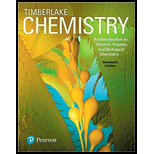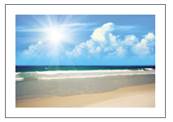
Chemistry: An Introduction to General, Organic, and Biological Chemistry (13th Edition)
13th Edition
ISBN: 9780134421353
Author: Karen C. Timberlake
Publisher: PEARSON
expand_more
expand_more
format_list_bulleted
Concept explainers
Textbook Question
Chapter 3, Problem 3.87APP
On a hot day, the beach sand gets hot but the water stays cool. Would you predict that the specific heat of sand is higher or lower than that of water? Explain. (3.6)

On a sunny day, the sand gets hot but the water stays cool.
Expert Solution & Answer
Trending nowThis is a popular solution!

Students have asked these similar questions
53. The combustion of glucose, CH1,O, forms carbon
dioxide gas and water vapour. When a 1.00 g sample
of glucose was burned, it raised the temperature
100.0 mL of water by 37.0 °C. (5.2, 5.3, 5.5) AA
(a) Write a balanced chemical equation for this reaction.
(b) Use AH to calculate the enthalpy change of this
of
reaction.
(c) Use bond energies in Table 1 on page 307 to
calculate the enthalpy change of this reaction.
The structural formula of glucose is shown in
Figure 1.
does it compare with the known melting and boiling point?
(1)
9. The average kinetic energy of water molecules is a measure of the temperature of
water. When the temperature of water remains constant the average kinetic energy of
the molecules remains constant, even though the water is being heated by the
Bunsen flame. So, energy is being taken in by the water, but it is not being used to
increase the kinetic energy of the molecules.
9.1 What type of energy are the water molecules gaining during a phase change?
(1)
9.2 Explain your reasoning (to question 9.1) with reference to the kinetic theory of matter.
10. Write the conclusion.
(3)
[30]
1. (9 points) A 15.0 gram piece of metal is heated to 65.0°C and then dropped
into 175 grams of 24.0°C water. The system eventually comes to a stable
temperature of 35.5 C. (The specific heat of water is 4.184 J/g °C)
a. Energy is absorbed by the water. What is qWATER?
b. Energy is released by the metal. What is qMETAL? (this one is easy)
c. What is the specific heat (Cs) of the metal?
Chapter 3 Solutions
Chemistry: An Introduction to General, Organic, and Biological Chemistry (13th Edition)
Ch. 3.1 - Prob. 3.1PPCh. 3.1 - Prob. 3.2PPCh. 3.1 - Classify each of the following as a pure substance...Ch. 3.1 - Classify each of the following as a pure substance...Ch. 3.1 - Prob. 3.5PPCh. 3.1 - Prob. 3.6PPCh. 3.2 - Indicate whether each of the following describes a...Ch. 3.2 - Indicate whether each of the following describes a...Ch. 3.2 - Describe each of the following as a physical or...Ch. 3.2 - Describe each of the following as a physical or...
Ch. 3.2 - Prob. 3.11PPCh. 3.2 - What type of change, physical or chemical, takes...Ch. 3.2 - Describe each property of the element fluorine as...Ch. 3.2 - Describe each property of the element zirconium as...Ch. 3.3 - Prob. 3.15PPCh. 3.3 - Prob. 3.16PPCh. 3.3 - Prob. 3.17PPCh. 3.3 - Calculate the unknown temperature in each of the...Ch. 3.3 - Prob. 3.19PPCh. 3.3 - a. Water is heated to 145 °F. What is the...Ch. 3.4 - Discuss the changes in the potential and kinetic...Ch. 3.4 - Prob. 3.22PPCh. 3.4 - Indicate whether each of the following statements...Ch. 3.4 - Prob. 3.24PPCh. 3.4 - Convert each of the following energy units: a....Ch. 3.4 - Prob. 3.26PPCh. 3.4 - The energy needed to keep a 75-wattlight bulb...Ch. 3.4 - Prob. 3.28PPCh. 3.5 - Calculate the kilocalories for each of the...Ch. 3.5 - Calculate the kilocalories for each of the...Ch. 3.5 - Using the energy values for foods (see TABLE3.7),...Ch. 3.5 - Using the energy values for foods (see TABLE3.7),...Ch. 3.5 - Prob. 3.33PPCh. 3.5 - Prob. 3.34PPCh. 3.5 - Prob. 3.35PPCh. 3.5 - Prob. 3.36PPCh. 3.6 - If the same amount of heat is supplied to samples...Ch. 3.6 - Substances A and B are the same mass and at the...Ch. 3.6 - Use the heat equation to calculate the energy for...Ch. 3.6 - Use the heat equation to calculate the energy for...Ch. 3.6 - Use the heat equation to calculate the energy, in...Ch. 3.6 - Use the heat equation to calculate the energy, in...Ch. 3.7 - Identify each of the following changes of state as...Ch. 3.7 - Identify each of the following changes of state as...Ch. 3.7 - Calculate the heat change at 0 °C for each of the...Ch. 3.7 - Prob. 3.46PPCh. 3.7 - Identify each of the following changes of state as...Ch. 3.7 - Identify each of the following changes of state as...Ch. 3.7 - Prob. 3.49PPCh. 3.7 - 3.50 Calculate the heat change at 100 °C for each...Ch. 3.7 - Prob. 3.51PPCh. 3.7 - Prob. 3.53PPCh. 3.7 - Prob. 3.54PPCh. 3.7 - Prob. 3.55PPCh. 3.7 - Prob. 3.56PPCh. 3.7 - Prob. 3.57PPCh. 3.7 - Prob. 3.58PPCh. 3 - Prob. 3.59UTCCh. 3 - Prob. 3.60UTCCh. 3 - Prob. 3.61UTCCh. 3 - Prob. 3.62UTCCh. 3 - Prob. 3.63UTCCh. 3 - Prob. 3.64UTCCh. 3 - Prob. 3.65UTCCh. 3 - Prob. 3.66UTCCh. 3 - Calculate the energy to heat two cubes (gold and...Ch. 3 - Calculate the energy to heat two cubes (silver and...Ch. 3 - Prob. 3.69UTCCh. 3 - Prob. 3.70UTCCh. 3 - Prob. 3.71APPCh. 3 - Prob. 3.72APPCh. 3 - Prob. 3.73APPCh. 3 - Prob. 3.74APPCh. 3 - Prob. 3.75APPCh. 3 - Prob. 3.76APPCh. 3 - Prob. 3.77APPCh. 3 - Prob. 3.78APPCh. 3 - Prob. 3.79APPCh. 3 - Prob. 3.80APPCh. 3 - Prob. 3.81APPCh. 3 - Calculate each of the following temperatures in...Ch. 3 - What is 15 °F in degrees Celsius and in kelvins?...Ch. 3 - Prob. 3.84APPCh. 3 - A 0.50-g sample of vegetable oil is placed in a...Ch. 3 - A 1.3-g sample of rice is placed in a calorimeter....Ch. 3 - On a hot day, the beach sand gets hot but the...Ch. 3 - On a hot sunny day, you get out of the swimming...Ch. 3 - Prob. 3.89APPCh. 3 - Prob. 3.90APPCh. 3 - The melting point of dibromomethane is 53 °C and...Ch. 3 - Prob. 3.92APPCh. 3 - Prob. 3.93APPCh. 3 - Prob. 3.94APPCh. 3 - Prob. 3.95APPCh. 3 - Prob. 3.96APPCh. 3 - Prob. 3.97CPCh. 3 - A 45-g piece of ice at 0.0 °C is added to a sample...Ch. 3 - Prob. 3.99CPCh. 3 - Prob. 3.100CPCh. 3 - Prob. 3.101CPCh. 3 - A 115-g sample of steam at 100 °C is emitted from...Ch. 3 - Prob. 3.103CPCh. 3 - 3.104 A 125-g piece of metal is heated to 288 °C...Ch. 3 - A metal is thought to be titanium or aluminum....Ch. 3 - 3.106 A metal is thought to be copper or gold....Ch. 3 - Gold, one of the most sought-after metals in the...Ch. 3 - The mileage for a motorcycle with a fuel-tank...Ch. 3 - Answer the following for water samples A and B...Ch. 3 - Prob. 4CICh. 3 - Prob. 5CICh. 3 - Prob. 6CI
Knowledge Booster
Learn more about
Need a deep-dive on the concept behind this application? Look no further. Learn more about this topic, chemistry and related others by exploring similar questions and additional content below.Similar questions
- 3.68 Calculate the energy to heat two cubes (silver and copper), each with a volume of 10.0 cm from 15 °C to 25 °C. Refer to Tables 2.9 and 3.11. (3.6)arrow_forward(7.6)Aluminum oxide decomposes to aluminum and oxygen gas by the following reaction. Al2O3(s)- → 2Al(s) + 3/2 O2(g) A Hrxn 1676 kJ = Is this reaction endothermic or exothermic? [Choose ] [Choose 1676 kJ If 1.049 moles of aluminum was formed by the reaction, how much heat (kJ) would be involved? 440 kJ endothermic 1760 kJ 879 kJ exothermicarrow_forwardA coffee cup calorimeter contains 25.0 g water at 23.8 C. A 5.00 g sample of an unknown metal at an initial temperature of 78.3 C was dropped into the calorimeter. The final temperature of mixture was 46.3 C. Calculate the specific heat of the metal. The specific heat of water is (4.184)arrow_forward
- A cedarcrest.instructure.com Homework Set #2 Join conversation 16. Calculate the heat capacity of a brick if a 100. g sample absorbs 2439 J of heat, and its temperature changes from 28.0°C to 57.0°C. (3.6)arrow_forwardWhat is the enthalpy change when 0.1 moles of ethanol undergoes complete combustion? The molar enthalpy for the combustion of ethanol is -1211 kJ/mol. Is the reaction exothermic or endothermic? (1:3)arrow_forward(Q6) Nitroglycerine combustion takes place in a bomb calorimeter that is insulated by 639.6 grams of water. Given that the specific heat of the bomb calorimeter is 1,015 J/°C, and the temperature of the water increased by 38.04 °C, how much heat (in kJ) was released as a result of the combustion? (3 sf)arrow_forward
- When 1.0 g of gasoline burns, it releases 11 kcal. The density of gasoline is 0.74 g/mL. (3.4, 3.6) How many megajoules are released when 1.0 gal of gasoline burns? If a television requires 150 kJ/h to run, how many hours can the television run on the energy provided by 1.0 gal of gasoline?arrow_forward.. The temperature of a 15.0 g sample of a metal (specific heat 0.040 J/g.°C) is raised by 18.2°C. How much heat (in J) has been absorbed by the metal? (15.09)(0.040g )arrow_forwardHow much heat (in J) is required to raise the temperature of a block made of pure copper was a mass of 8.12 grams by 8.86 °C? (3 sf)arrow_forward
- 16. A 200. g sample of titanium (specific heat of 0.52 J/g°C) is initially at 20.0 °C. If the sample absorbs 3600 J of heat, what is its final temperature? (2 points)arrow_forwardThe combustion of wood produces an average of 15 000 kJ/kg. Suppose 4.30 kg of wood is burned in a fireplace that circulates heat around a house containing 800.0 kg of air (Cair = 1.02 kJ/kg°C), increasing the average air temperature of the house from 18°C to 23°C. a. What percentage of the wood's energy went directly into heating the air? (3) b. Brick (in addition to being non-flammable) has a high specific heat capacity. Why does it make sense in terms of energy efficiency to surround fireplaces with brick? (2)arrow_forward7.72 Classify each of the following as exothermic or endothermic: a. C3Hg(g) + 502(g) b. 2Na(s) + Cl,(g) c. PCI5(g) + 67 kJ → 3CO2(g) + 4H,O(g) + 2220 kJ 2NACI(s) + 819 kJ > PCI,(g) + Cl2(g)arrow_forward
arrow_back_ios
SEE MORE QUESTIONS
arrow_forward_ios
Recommended textbooks for you
 ChemistryChemistryISBN:9781305957404Author:Steven S. Zumdahl, Susan A. Zumdahl, Donald J. DeCostePublisher:Cengage Learning
ChemistryChemistryISBN:9781305957404Author:Steven S. Zumdahl, Susan A. Zumdahl, Donald J. DeCostePublisher:Cengage Learning ChemistryChemistryISBN:9781259911156Author:Raymond Chang Dr., Jason Overby ProfessorPublisher:McGraw-Hill Education
ChemistryChemistryISBN:9781259911156Author:Raymond Chang Dr., Jason Overby ProfessorPublisher:McGraw-Hill Education Principles of Instrumental AnalysisChemistryISBN:9781305577213Author:Douglas A. Skoog, F. James Holler, Stanley R. CrouchPublisher:Cengage Learning
Principles of Instrumental AnalysisChemistryISBN:9781305577213Author:Douglas A. Skoog, F. James Holler, Stanley R. CrouchPublisher:Cengage Learning Organic ChemistryChemistryISBN:9780078021558Author:Janice Gorzynski Smith Dr.Publisher:McGraw-Hill Education
Organic ChemistryChemistryISBN:9780078021558Author:Janice Gorzynski Smith Dr.Publisher:McGraw-Hill Education Chemistry: Principles and ReactionsChemistryISBN:9781305079373Author:William L. Masterton, Cecile N. HurleyPublisher:Cengage Learning
Chemistry: Principles and ReactionsChemistryISBN:9781305079373Author:William L. Masterton, Cecile N. HurleyPublisher:Cengage Learning Elementary Principles of Chemical Processes, Bind...ChemistryISBN:9781118431221Author:Richard M. Felder, Ronald W. Rousseau, Lisa G. BullardPublisher:WILEY
Elementary Principles of Chemical Processes, Bind...ChemistryISBN:9781118431221Author:Richard M. Felder, Ronald W. Rousseau, Lisa G. BullardPublisher:WILEY

Chemistry
Chemistry
ISBN:9781305957404
Author:Steven S. Zumdahl, Susan A. Zumdahl, Donald J. DeCoste
Publisher:Cengage Learning

Chemistry
Chemistry
ISBN:9781259911156
Author:Raymond Chang Dr., Jason Overby Professor
Publisher:McGraw-Hill Education

Principles of Instrumental Analysis
Chemistry
ISBN:9781305577213
Author:Douglas A. Skoog, F. James Holler, Stanley R. Crouch
Publisher:Cengage Learning

Organic Chemistry
Chemistry
ISBN:9780078021558
Author:Janice Gorzynski Smith Dr.
Publisher:McGraw-Hill Education

Chemistry: Principles and Reactions
Chemistry
ISBN:9781305079373
Author:William L. Masterton, Cecile N. Hurley
Publisher:Cengage Learning

Elementary Principles of Chemical Processes, Bind...
Chemistry
ISBN:9781118431221
Author:Richard M. Felder, Ronald W. Rousseau, Lisa G. Bullard
Publisher:WILEY
Calorimetry Concept, Examples and Thermochemistry | How to Pass Chemistry; Author: Melissa Maribel;https://www.youtube.com/watch?v=nSh29lUGj00;License: Standard YouTube License, CC-BY